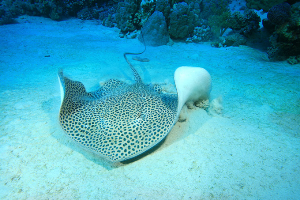Nov 8 2013
Recent studies show stingrays are the hybrid cars of the ocean.
 Stingrays' unique swimming motion is the basis of research by UB mechanical engineers.
Stingrays' unique swimming motion is the basis of research by UB mechanical engineers.
The flat fish move through water with such ease that researchers from UB and Harvard University are studying how stingray movements could be used to build more agile and maneuverable unmanned underwater vehicles.
The vehicles could allow researchers to more efficiently study the mostly unexplored ocean depths, as well as take part in cleanup and rescue efforts.
“Most fish wag their tails to swim. A stingray’s swimming is much more unique, like a flag in the wind,” says Richard Bottom, a UB mechanical engineering graduate student who is participating in the research. “I've always wondered why they were unique. This research is figuring that out.”
Bottom and Iman Borazjani, assistant professor in the Department of Mechanical and Aerospace Engineering, set out to investigate the form-function relationship of the stingray: why does it look the way it does and what does it achieve by moving the way it does?
Colleagues at Harvard, working with live stingrays, gathered data on stingray body shape, motion, speed, etc. The UB researchers took that data and used supercomputers and computational fluid dynamics, a method of using algorithms to solve problems that involve fluid flows, to calculate the flow of water and the vortices around the live stingrays.
Borazjani and Bottom will explain the relationship and their findings on Nov. 24 at the 66th Annual Meeting of the American Physical Society Division of Fluid Dynamics in Pittsburgh. Their lecture is titled “Biofluids: Locomotion III — Flying.”
Borazjani’s previous work, which was published in Proceedings of the Royal Society, examined the leading-edge vortex — the vortex at the front edge of the object in motion — for the first time in underwater locomotion. The leading-edge vortex has been observed in the flight of birds and insects, and is one of the most important thrust-enhancement mechanisms in insect flight, Borazjani explains.
The same vortex is found in swimming stingray. The vortices on the waves of the stingrays’ bodies cause favorable pressure fields — low pressure on the front and high pressure on the back — that push the ray forward. Because movement through air and water are similar, understanding vortices is critical.
“By looking at nature, we can learn from it and come up with new designs for cars, planes and submarines,” says Borazjani. “But we’re not just mimicking nature. We want to understand the underlying physics for future use in engineering or bio-inspired designs.”
Studies already have shown that stingray motion closely resembles the most optimal swimming gait, says Bottom. Much of this is due to the stingray’s unique flat and round shape, which allows it to easily glide through water.
But while the stingray’s distinctiveness has earned it attention in the lab, it plays a comforting role in Bottom’s life as well. In addition to attending graduate school, Bottom works full time as an applications engineer at Niagara Thermal Products, where he handles new product development.
“Whenever schoolwork gets to be too much, I park myself in front of my fish tank and relax,” says Bottom, who owns a pet ray. “There is something mesmerizing about watching a stingray.”
The research placed first in the UB Mechanical Aerospace Engineering Graduate Poster Competition. Borazjani and Bottom plan to continue their research and study the differences in movement among several types of rays.